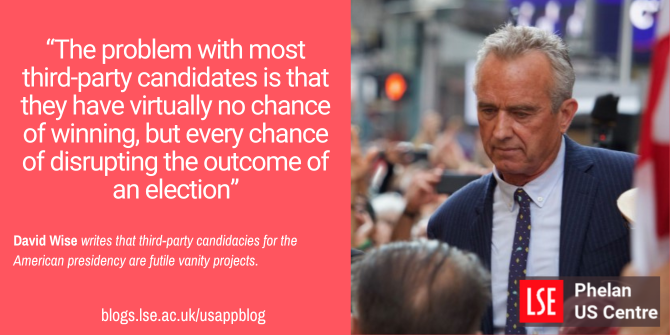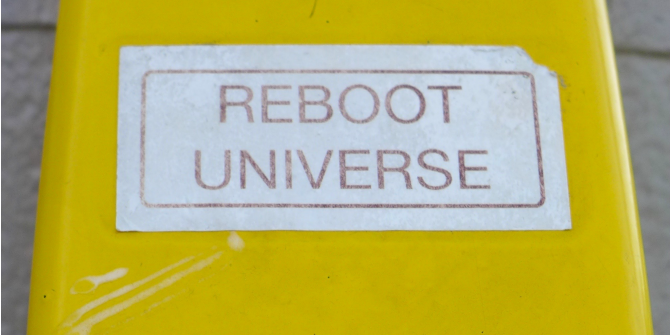 Earlier this month, Robert F. Kennedy Jr. announced that he would be running for the presidency as an independent – or third party – candidate. David Wise looks at the history of candidates not aligned with the Republican or Democratic parties, noting that such presidential bids are known as the “ultimate vanity project” and, thus far, have only been election disruptors, not winners.
Earlier this month, Robert F. Kennedy Jr. announced that he would be running for the presidency as an independent – or third party – candidate. David Wise looks at the history of candidates not aligned with the Republican or Democratic parties, noting that such presidential bids are known as the “ultimate vanity project” and, thus far, have only been election disruptors, not winners.
“The viable third-party presidential option, “in the words of political commentator Zachary Wolf, “is the fever dream of American politics.” Inevitably, it appears in some form every four years, in part because of dissatisfaction with the major party offerings, and in part to fill some newspaper copy over the course of what have become long campaigns. This year the topic is more relevant given the declaration by Robert F. Kennedy Jr. and with No Labels waiting in the wings.
Since 1900 there have been ten significant independent presidential candidates, in eight elections. The best that any candidate has done was Theodore Roosevelt’s Progressive/Bull Moose Party in 1912 that came in second place by carrying six states and 27.4 percent of the vote while garnering eighty-eight electoral votes. Only three out of ten times have the candidates scored in double digits. Only four times have candidates carried even a single state or received an Electoral Vote. Two times a third-party candidate changed the result of the election and came remarkably close in a third. In three cases the candidate’s objective was, not to win, but to disrupt the results. In the other cases, the independent candidate had no effect on the election outcome, including two strong left-leaning candidacies that won 6.0 percent and 2.4 percent of the vote and came in fourth in 1912 and 1948.
Only two candidates went into election with some possibility of establishing a viable broad-based party, Roosevelt in 1912 and Ross Perot with the Reform Party in 1996 or with credible potential paths of victory, again Roosevelt in 1912 and Perot in 1992. People forget that when Perot dropped out of the race temporarily in 1992, he was polling ahead of both George HW Bush and Bill Clinton. In the fall though, he won neither any states nor Electoral Votes. In the words of historian Richard Hofstadter, “Third parties are like bees. Once they have stung, they die.”
Ross Perot’s candidacies are particularly interesting as he received a substantial vote count in both elections but did not affect the outcome in either race. In 1992 Perot received 18.9 percent of the vote and 8.4 percent in 1996; however, he carried no states. Rather than taking votes disproportionately away from either candidate, Perot struck a chord with a tier disaffected voters who would ordinarily have stayed home. In 1992, voter turnout increased by 12.9 million over 1988 and Perot received 19.7 million votes. In 1996 voter turnout was 9 million below 1992 and Perot’s vote total decreased 11.7 million.

“Robert F. Kennedy Jr. Health Freedom Ral” (CC BY-NC 2.0) by pameladrew212
Third party candidates are election disruptors – not winners
The problem with most third-party candidates is that they have virtually no chance of winning, but every chance of disrupting the outcome of an election. The United States has a first past the post system, which means that the candidate with even a plurality of votes wins all the Electoral Votes from that state. Roosevelt, in 1912, was the only independent candidate to come in as high as second but was still 178 Electoral Votes short of winning the election. In 1912, Roosevelt took votes away from William Howard Taft, who had been his chosen Republican successor, gifting the election to Woodrow Wilson. In 1908, Taft, the Republican candidate, received 7,678,395 votes in 2008. In 1912 Taft and Roosevelt had combined 7,608,963.
In 1968, George Wallace received 13.5 percent of the popular vote while collecting 46 Electoral Votes. Although nominally a Democrat at a time when most southern politicians were Democrats, Wallace, a segregationist, had precious little in common with the Democratic nominee, Hubert Humphrey, an outspoken advocate for civil rights. Due to Wallace’s presence, however, the Republican candidate, Richard Nixon only narrowly outpolled Humphrey 43.4 percent to 42.7 percent. Four years later in 1972, with Wallace out of the race, Nixon won all five states that Wallace had carried, and his state-by-state popular vote percentages matched almost exactly the combined percentages by state of Nixon and Wallace from 1968.
The most recent case was in 2000 when Green Party candidate, Ralph Nader, received just 2.7 percent of the vote. In that year the Democratic candidate, Al Gore lost the election by failing to carry Florida by just 537 votes. Polls showed that Nader voters were more likely to vote for Gore or stay home. Had Nader not been on the ballot and had just one out of every 181 of his voters shown up to vote for Gore the latter would have been elected president. It is due to the high probability of disrupting the election that many call third party campaigns, with justification, the ultimate vanity project. This is even true of Theodore Roosevelt, who could not bear to lose the limelight to his successor.
Electoral College strategies
There were also three times where southern segregationists attempted to use the vagaries of the Electoral College to disrupt elections, thereby acquiring maximum bargaining position for their views. In 1948, South Carolina Governor Strom Thurmond led the so-called Dixiecrats out of the Democratic National Convention in protest of the party’s strong civil rights plank. Thurmond then ran as an independent in the hope of capturing the south’s 127 Electoral Votes forcing the race into the House where it could use its bargaining power to squeeze concessions out of Truman and the Republican candidate Thomas Dewey.
George Wallace pursued a similar strategy in 1968. Although Thurmond and Wallace received 39 and 46 Electoral Votes, respectively, they were unable to throw the election into the House. In 1960 Harry Byrd of Virginia used his candidacy to try to deny southern Electoral Votes from the party’s nominee, Jack Kennedy, who was a Catholic and northern liberal. Despite Byrd receiving fifteen Electoral Votes Kennedy was still able win 303 Electoral Votes and the election.
The third-party candidacy that most represents the statistical average performance out of these instances was that of Congressman John Anderson in 1980. Anderson, a liberal Republican, decided not to run for reelection for Congress as he was targeted for primary opposition by the conservative national party. Instead, he announced his candidacy for the Republican nomination for president. Early in the campaign Anderson received glowing press. He became so fond of his press clippings that he announced an independent candidacy that received 6.6 percent of the popular vote, while winning no states or Electoral Votes. Anderson had no impact on the election as Ronald Reagan won in a landslide.
American presidential elections are susceptible to disruption by third parties. Third party candidates strip votes away from the candidate that has the closest crossover with their views, inadvertently helping the candidate that is least palatable to their own voters. This happened in 1912 and 2000 and almost in 1968. Given the tight races in the Electoral College in recent elections, there is concern that RFK JR could have that impact in 2024 even if he does not get a considerable number of popular votes. Even if, against all odds, the third party threw the election into the House of Representatives, it would have virtually no chance of winning since it would have no members of its party in the House of Representatives that would decide the election.
Please read our comments policy before commenting.
Note: This article gives the views of the author, and not the position of USAPP – American Politics and Policy, nor the London School of Economics.
Shortened URL for this post: https://bit.ly/3SlaNXA






